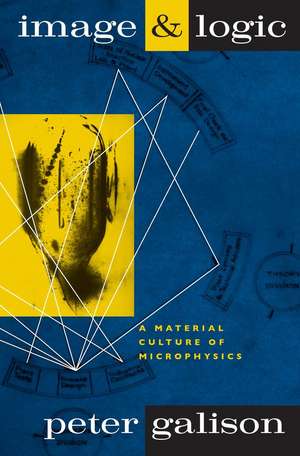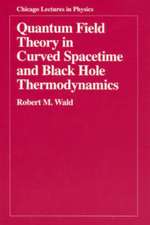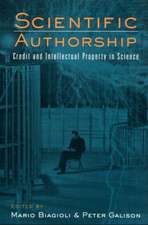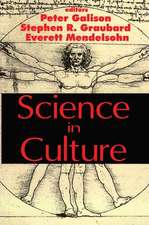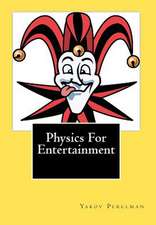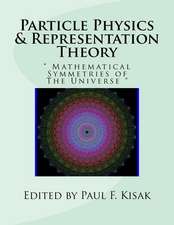Image and Logic: A Material Culture of Microphysics
Autor Peter Galisonen Limba Engleză Paperback – oct 1997
"I want to get at the blown glass of the early cloud chambers and the oozing noodles of wet nuclear emulsion; to the resounding crack of a high-voltage spark arcing across a high-tension chamber and leaving the lab stinking of ozone; to the silent, darkened room, with row after row of scanners sliding trackballs across projected bubble-chamber images. Pictures and pulses—I want to know where they came from, how pictures and counts got to be the bottom-line data of physics." (from the preface)
Image and Logic is the most detailed engagement to date with the impact of modern technology on what it means to "do" physics and to be a physicist. At the beginning of this century, physics was usually done by a lone researcher who put together experimental apparatus on a benchtop. Now experiments frequently are larger than a city block, and experimental physicists live very different lives: programming computers, working with industry, coordinating vast teams of scientists and engineers, and playing politics.
Peter L. Galison probes the material culture of experimental microphysics to reveal how the ever-increasing scale and complexity of apparatus have distanced physicists from the very science that drew them into experimenting, and have fragmented microphysics into different technical traditions much as apparatus have fragmented atoms to get at the fundamental building blocks of matter. At the same time, the necessity for teamwork in operating multimillion-dollar machines has created dynamic "trading zones," where instrument makers, theorists, and experimentalists meet, share knowledge, and coordinate the extraordinarily diverse pieces of the culture of modern microphysics: work, machines, evidence, and argument.
Image and Logic is the most detailed engagement to date with the impact of modern technology on what it means to "do" physics and to be a physicist. At the beginning of this century, physics was usually done by a lone researcher who put together experimental apparatus on a benchtop. Now experiments frequently are larger than a city block, and experimental physicists live very different lives: programming computers, working with industry, coordinating vast teams of scientists and engineers, and playing politics.
Peter L. Galison probes the material culture of experimental microphysics to reveal how the ever-increasing scale and complexity of apparatus have distanced physicists from the very science that drew them into experimenting, and have fragmented microphysics into different technical traditions much as apparatus have fragmented atoms to get at the fundamental building blocks of matter. At the same time, the necessity for teamwork in operating multimillion-dollar machines has created dynamic "trading zones," where instrument makers, theorists, and experimentalists meet, share knowledge, and coordinate the extraordinarily diverse pieces of the culture of modern microphysics: work, machines, evidence, and argument.
Preț: 468.07 lei
Preț vechi: 577.87 lei
-19% Nou
Puncte Express: 702
Preț estimativ în valută:
89.58€ • 97.27$ • 75.24£
89.58€ • 97.27$ • 75.24£
Carte tipărită la comandă
Livrare economică 23 aprilie-07 mai
Preluare comenzi: 021 569.72.76
Specificații
ISBN-13: 9780226279176
ISBN-10: 0226279170
Pagini: 982
Ilustrații: 85 halftones, 113 line drawings
Dimensiuni: 152 x 229 x 51 mm
Greutate: 1.27 kg
Ediția:1
Editura: University of Chicago Press
Colecția University of Chicago Press
ISBN-10: 0226279170
Pagini: 982
Ilustrații: 85 halftones, 113 line drawings
Dimensiuni: 152 x 229 x 51 mm
Greutate: 1.27 kg
Ediția:1
Editura: University of Chicago Press
Colecția University of Chicago Press
Notă biografică
Peter Galison is Mallinckrodt Professor of the History of Science and of Physics at Harvard University. He is author of How Experiments End, published by the University of Chicago Press, and coeditor of The Disunity of Science: Contexts, Boundaries, and Power.
Cuprins
List of Figures
Preface
1: Introduction: Image and Logic
2: Cloud Chambers: The Peculiar Genius of British Physics
3: Nuclear Emulsions: The Anxiety of the Experimenter
4: Laboratory War: Radar Philosophy and the Los Alamos Man
5: Bubble Chambers: Factories of Physics
6: The Electronic Image: Iconoclasm and the New Icons
7: Time Projection Chambers: An Image Falling through Space
8: Monte Carlo Simulations: Artificial Reality
9: The Trading Zone: Coordinating Action and Belief
Abbreviations for Archival Sources
Bibliography
Index
Preface
1: Introduction: Image and Logic
2: Cloud Chambers: The Peculiar Genius of British Physics
3: Nuclear Emulsions: The Anxiety of the Experimenter
4: Laboratory War: Radar Philosophy and the Los Alamos Man
5: Bubble Chambers: Factories of Physics
6: The Electronic Image: Iconoclasm and the New Icons
7: Time Projection Chambers: An Image Falling through Space
8: Monte Carlo Simulations: Artificial Reality
9: The Trading Zone: Coordinating Action and Belief
Abbreviations for Archival Sources
Bibliography
Index
